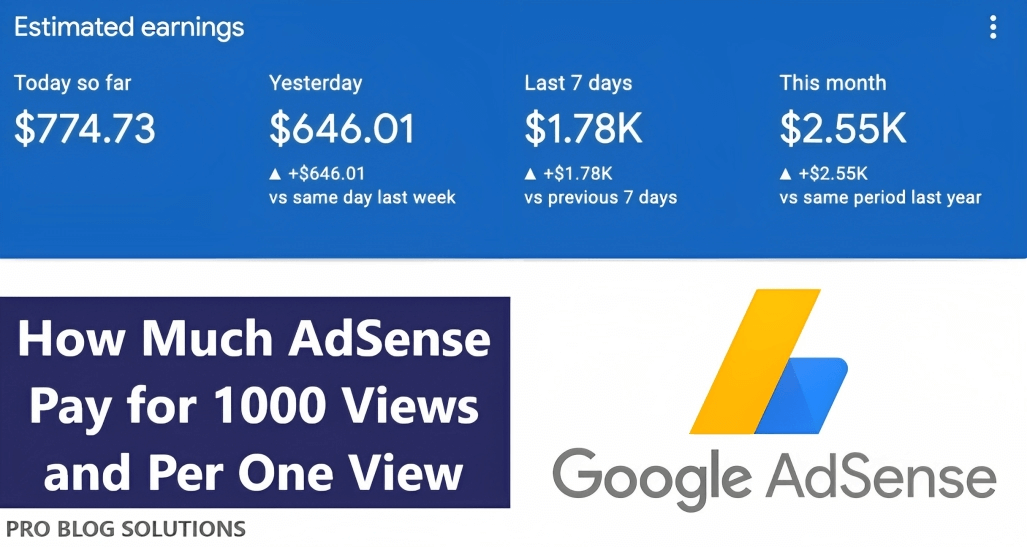Google AdSense is a well-known advertising program that enables content creators and publishers to monetize their online content by displaying targeted ads to their audiences. One of the most frequently asked questions by publishers is how much AdSense pay for 1000 views and per one view.
To answer this question, we first need to understand how AdSense works and the factors that can affect publishers' earnings.
How Does AdSense Work in 2025?
Google AdSense is a program that allows website owners to earn money by displaying ads. It's a complex system, but here's a breakdown of the key players and processes involved:
1. The Players:
Website owners: You own the website where the ads will be displayed.
Advertisers: Businesses or individuals who want to promote their products or services by displaying ads on other websites.
Google: The middleman and technology provider that connects advertisers with website owners.
2. The Process:
a) Setting Up AdSense:
- You sign up for a free AdSense account and provide information about your website.
- Google analyzes your website content and identifies potential places to display ads.
- You choose the types of ads you want to show (text, banner, video, etc.) and customize their size and appearance.
b) Ad Matching and Auction:
- Advertisers create campaigns in Google Ads and set how much they will pay per click (CPC) or per thousand impressions (CPM) on their ads.
- When a user visits your website, Google matches relevant ads from the advertiser pool to your content and audience.
- An auction in real time determines which ad will be displayed. The highest bidder wins the ad spot and pays Google the bid amount.
c) Revenue Generation and Payment:
- If a user clicks on an ad on your website, you earn the CPC amount that the advertiser bid.
- If a specific type of ad receives 1,000 impressions, you earn the CPM amount set by the advertiser.
- Google deducts its commission (usually around 32%) and then sends you the remaining monthly amount.
Additional Details:
Targeting: Google can target ads based on website content, user demographics, interests, and browsing history.
Ad Relevance: Google aims to show relevant ads to users, improving their experience and increasing the chances of a click.
Performance Tracking: You can track your AdSense earnings through detailed reports that show ad impressions, clicks, and revenue generated.
Policy Compliance: You must follow Google AdSense policies to avoid account suspension. This includes not clicking on your ads and ensuring your website content is high-quality and original.
Benefits of Using AdSense:
- Easy to set up and use.
- Access to a large pool of advertisers.
- Automatic ad matching and targeting.
- Detailed performance tracking.
- It can be a passive source of income.
Things to Consider Before Using Adsense in 2025:
- Competition can be high, and earnings can vary significantly.
- Ad relevance is crucial for user experience and revenue generation.
- AdSense policies need to be followed strictly.
This detailed explanation gives you a good understanding of how Google AdSense works. Let's explain how much AdSense pays for 1000 views in 2025.
What Factors Affect AdSense Earnings?
Factors Affecting AdSense Earnings in 2025: A Comprehensive Breakdown
AdSense earnings can be a bit of a mystery, fluctuating over time and seemingly defying explanation. But fret not! While predicting exact earnings is impossible, understanding the critical factors can equip you to optimize your approach and boost your income.
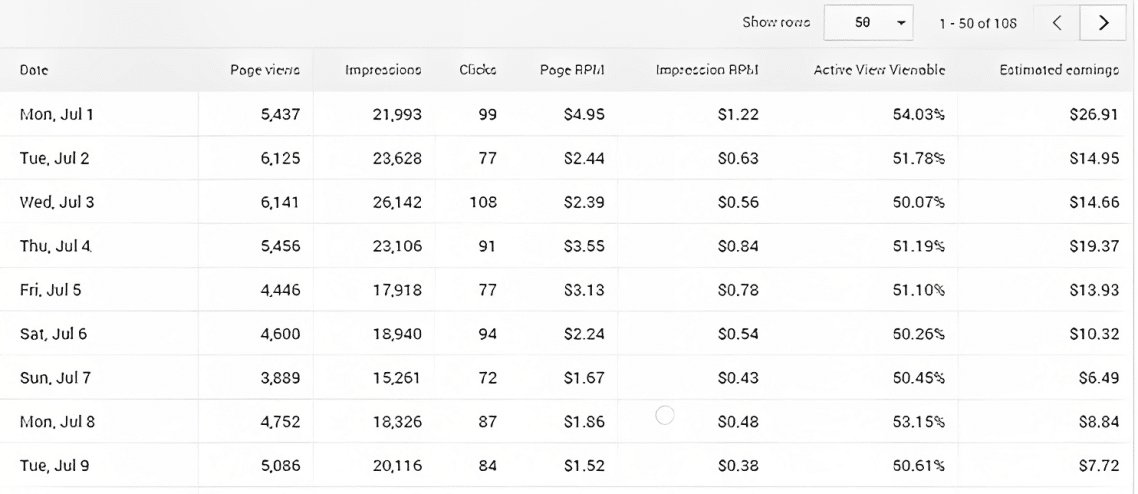
Here's a deep dive into the variables influencing your AdSense success with various factors that can affect AdSense earnings, including the following:
Traffic:
Volume: More traffic generally leads to more ad impressions and potential clicks. Focus on growing your audience through SEO, social media, and engaging content strategies.
Source: Not all traffic is created equal. Organic traffic tends to convert better than paid traffic, and visitors from certain countries have higher average CPCs (cost-per-click). Analyze your traffic sources to understand where your highest-value visitors come from.
Quality: Irrelevant or low-quality traffic can lead to invalid clicks and harm your account. Ensure your audience aligns with your content and implement measures to prevent bot traffic.
Content:
Relevance: Ads displayed must be relevant to your content. This increases user engagement and the likelihood of clicks. Consider your audience's interests and needs when choosing ad units and placement.
Engaging: Captivating content keeps users on your site longer, exposing them to more ads. Focus on high-quality content that resonates with your audience and encourages interaction.
Seasonality: Some topics and industries exhibit seasonal trends in their profitability. Understanding these trends can help you adjust your content strategy to capitalize on peak periods.
Ads and Targeting:
Ad formats: Experiment with different ad formats (display, text, video, etc.) to see which performs best on your site. A/B testing can help you find the optimal combination.
Ad placement: Strategic placement of ad units significantly impacts user experience and click-through rates (CTRs). Test different placements to find sweet spots that balance unobtrusiveness with visibility.
Targeting: Fine-tuning ad targeting to specific demographics and interests can attract higher-paying advertisers and increase CPCs. However, overly narrow targeting might limit your reach and impressions.
Technical Factors:
Website speed: Slow loading times can hurt user experience and discourage clicks. Optimize your website speed for the best results.
Mobile responsiveness: With mobile-dominating browsing, a mobile-friendly website is crucial. Ensure your ads display correctly and adapt to different devices.
Ad blockers: Some users have ad blockers, reducing potential impressions. Analyze your data to understand the impact and explore non-intrusive ad formats.
External Factors:
Competition: High competition in your niche can drive down CPCs. Finding a unique angle or focusing on less-saturated sub-niches could be beneficial.
Economic climate: Downturns can affect advertisers' budgets, leading to lower CPCs. Diversifying your content and revenue streams can mitigate this risk.
Google AdSense algorithm updates: Google's algorithm constantly evolves, sometimes impacting publisher earnings. Staying updated and adhering to AdSense policies is essential.
Below is the detailed data analysis chart of how much AdSense pays per 1000 views according to different niches.
Remember this before calculating how much AdSense pays for 1000 views in 2025?
- There's no magic formula for maximizing AdSense earnings.
- Experimentation, analysis, and continuous improvement are essential.
- Focus on providing high-quality content and user experience.
- Monitor your data, track trends, and adapt your strategy accordingly.
By understanding these factors and actively optimizing your website and content, you can unlock AdSense's full potential and achieve sustainable revenue growth.
You may also like to read:
- Advantages and Disadvantages of Distance Education
- Ultimate GreenGeeks Hosting Review With Pros & Cons
- 25 Best Chrome Extensions for Productivity
- GeneratePress vs. Genesis: 27 Results & Comparison Chart
- Eliminate Render-Blocking Resources With Async and Defer
How Much Can AdSense Pay Per One View in 2025?
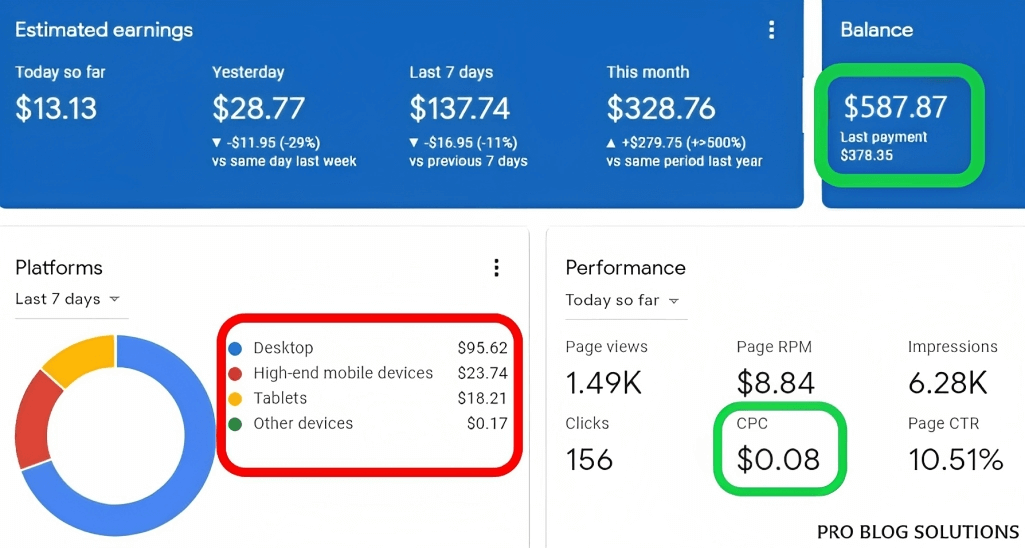
As discussed above, the amount of money earned per view on AdSense depends on various factors, such as ad relevance and traffic location. However, it is difficult to determine the exact amount that publishers can earn per view.
So, how much does Google Adsense pay per page view? Using the Google Adsense Page RPM formula, we can calculate how much you make from a pageview.
Not everyone indeed clicks on your ads. However, you still get paid for everyone who views Adverts on your website or blog. This is called Cost Per Thousand (CPM).
CPM is the amount you get per 1000 impressions on your ads. Impressions are the number of times Google Ads is seen on your blog. RPM is a metric used to determine the total ad revenue a publisher is set to earn for 1000 ad impressions. CPM, on the other hand, is the amount an advertiser will pay for 1000 ad impressions.
RPM stands for Revenue per thousand. Page RPM is how much you will earn per 1000 page views considering factors like your CPM, Cost per click (CPC), and click-through rate (CTR).
From your Page RPM, you can know how much Google will pay you on average per person who visits your blog. This is how it works.
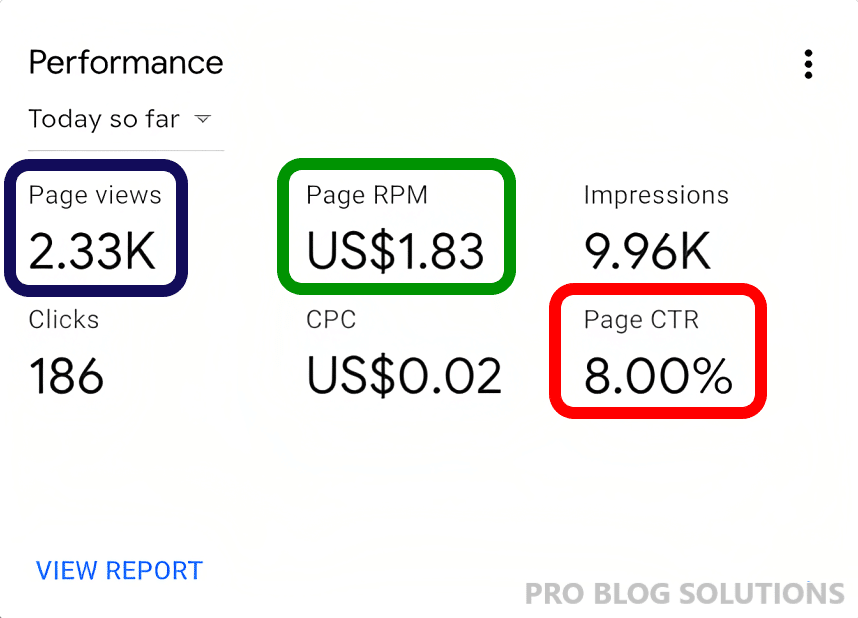
From the image above, the page RPM is $1.83. This means that one thousand page views will give you $ 1.83. Now, if 1000 views = $ 1.83, what will one page view give? Let’s solve the mathematics.
1000 views = $1.83
1 view = $X (unknown)
Cross multiplying
1000 views x $X = 1 views x $1.83
1000X = 1.83
Dividing both sides by 1000
X /1000= 1.83/1000
X = $0.00183
So, on the final result, a 1-page view will give you $0.00183
So, publishers can earn between $0.01 and $0.20 per view on AdSense. If a publisher's website generates 10,000 views daily, they can earn between $100 and $2000 daily.
AdSense Earnings Per 1000 views in the USA:
The United States of America (USA) is a country in North America. On average, traffic from the USA generates $11.99 for 1000 pageviews. The lowest RPM is $3.37 for news categories, and the highest is $32.13 for finance-related content.
AdSense Earnings Per 1000 views in the United Kingdom:
The United Kingdom is a country in Europe. AdSense pays, on average, $6 for every 1000 views from UK visitors on your site. The highest revenue per 1k impressions is $19.47 for the finance category, and the lowest is $2 for news content.
How Much Does AdSense Pay Per Click?
AdSense pays $0.20 to $18 per click on average in 2025. The total earnings for one-click depending on the competition between advertisers and the cost-per-click (CPC) in the website’s category. Publishers earn 68% of the payment from Google for AdSense content.
Let’s look at some of the best and worst-paying niches from the list. Electronics pays only $730 per 1000 clicks, Pharmaceuticals averages about $1 150 per 1000 clicks, and Fashion Retail follows it at $1 230 per 1000 clicks.
| Niche | Average CPC (cost-per-click) | Price per 1000 Clicks |
| Insurance | $17.55 | $17.550 |
| Online Education | $12.08 | $12.008 |
| Marketing and Advertising | $6.45 | $6.450 |
| Legal | $6.11 | $6.110 |
| Internet and Telecom | $4.96 | $4.960 |
| Fashion Retail | $1.23 | $1.230 |
| Pharmaceuticals | $1.15 | $1.150 |
| Electronics | $0.73 | $730 |
Focus on the most profitable niches if you want to make money through blogging and Google Adsense.
What is the AdSense Revenue Calculator?
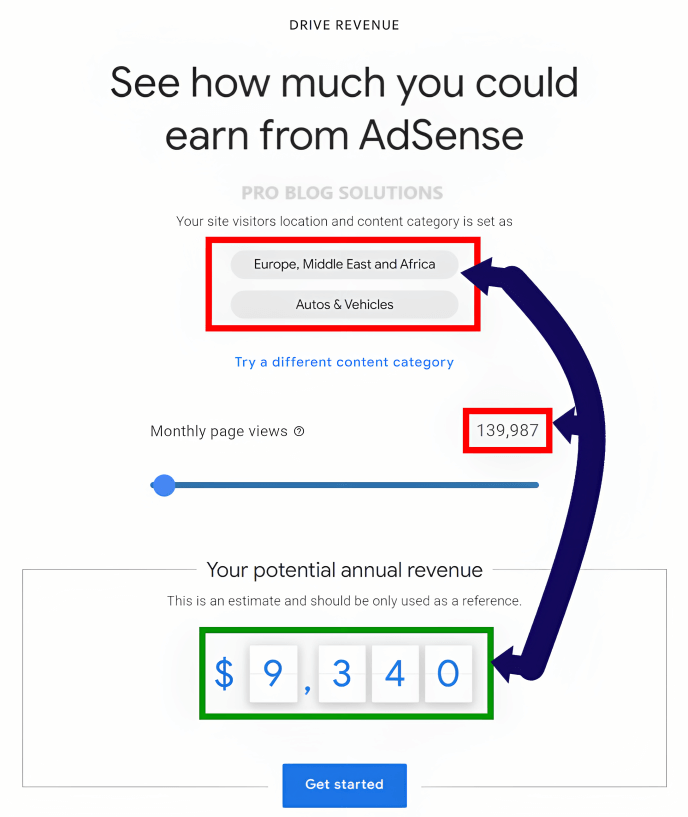
An AdSense revenue calculator allows you to estimate how much ad revenue your website can earn from AdSense. Users enter region, category, and page view data into the AdSense revenue calculator to receive an estimate.
AdSense revenue calculator uses data from Google to estimate how much a website will earn with AdSense. As a result, it provides accurate estimates for website owners.
How Much Does AdSense Pay Per 1,000 Views?
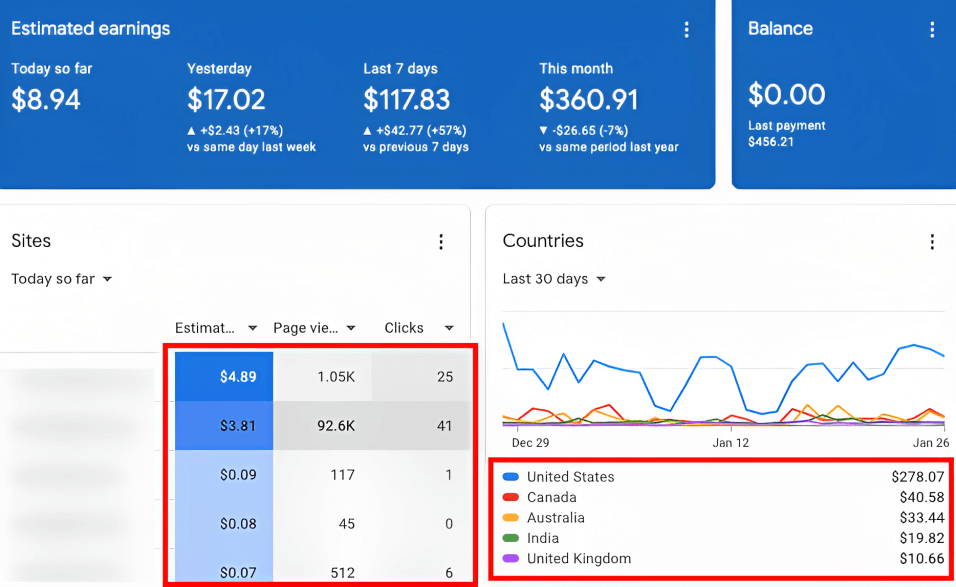
This question is most frequently asked, and also several answers are there. But still, we will answer this question. Let's assume that You placed 3 ads on each page, which means multiplying this number by page views equals 3×40000=120000 Ad views.
Here, we assume the average CPM (Cost for 1000 impressions) will be between $0.01 and $1. So, let's take 0.5$ as an average CPM. Note here that the rate is for eCPM, not for clicks, so the click rate will differ.
Calculate your earnings by applying this formula: Adviews x eCPM/1000, which means 120000×0.5/1000 = 60$. So you will earn 60$ for 40000 page views. Please note that this is an average; actual earnings will vary depending upon the type of ad serving.
This is not your earnings because Adsense is not a CPM-based network and is only one of its features. Adsense is a CPC network that pays the highest for clicks. So, let's make another calculation.
As of the above calculation, 120000 Ad views are generated every month. So whenever a user sees an ad, they like it and click it if they find it interesting.
Here, do not take adviews as a click calculation because it depends upon how many viewers you have. So, as you said, you have 40k monthly users, so let's assume that the least number of clicks, like you have got 1000 clicks total in a month and think that the CPC of that ad is $0.5 because the average CPC cost varies between 0.1 to 2$.
So here is your calculation:
1000 ad clicks x 0.5$ CPC rate = 500$
So, finally, here is your total monthly income for 40k visitors. $500 of clicks generated, $60 from impressions generated money, and the total is $560.
Example AdSense Earnings Per 1,000 Pageviews in 2025:
As we also mentioned above about some different niches of Adsense earnings, let's see some other estimated examples of how much AdSense pays for 1,000 views on a website in various categories:
- Arts & Entertainment: $5.62 per 1,000 pageviews.
- Autos & Vehicles: $9.20 per 1,000 pageviews.
- Beauty and Fitness: $13.01 per 1,000 pageviews.
- Finance: $32.13 per 1,000 pageviews.
- Food & Drink: $14.33 per 1,000 pageviews.
- Health: $17.40 per 1,000 pageviews.
- Home & Garden: $23.35 per 1,000 pageviews.
- Real Estate: $14.50 per 1,000 pageviews.
- Sports: $4.23 per 1,000 pageviews.
- Travel: $14.10 per 1,000 pageviews.
Please Note: These Google AdSense earnings per 1,000 visitors are based on sites targeting North America.
Recommended for you:
- How to Earn 10 Dollars Per Day From AdSense?
- HostArmada Review: Is It Fast and Stable Cloud Hosting?
- How to Make Firefox Faster than Chrome?
- ChemiCloud Review: Best Features of Amazing Web Host
- 89 High Domain Authority DoFollow Article Submission Sites
How to Optimize Your Blog for AdSense?
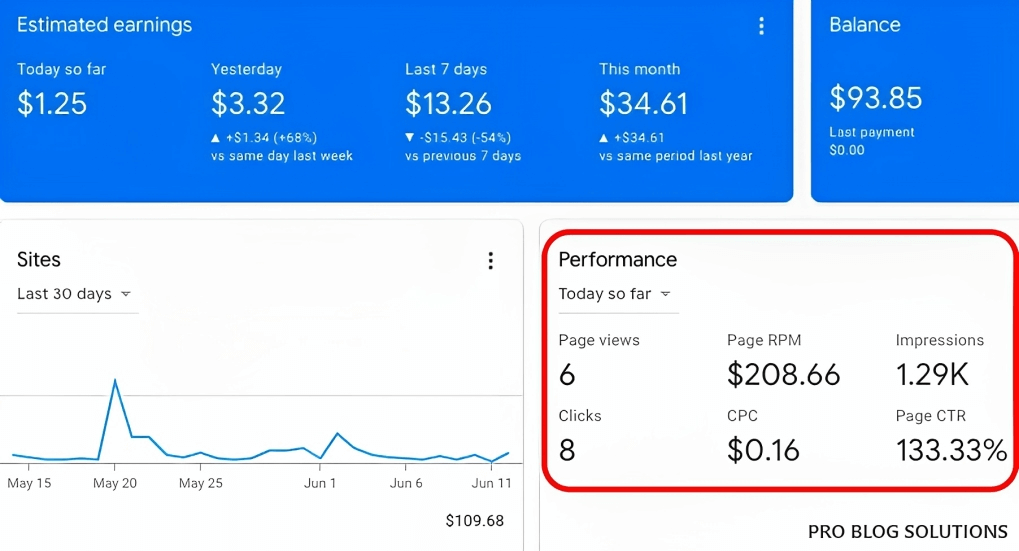
To optimize your blog for AdSense, you should follow these steps:
Research profitable niches:
Identify your area's most profitable niches and create content targeting those niches. This will help you attract more advertisers and increase your earnings.
Use industry-related keywords:
Use keyword research tools to find your niche's most popular and profitable keywords. Use these keywords in your content to optimize your blog for search engines and attract more visitors.
Use AdSense-friendly themes:
Use a theme optimized for AdSense to ensure your ads are displayed in the best possible positions and easily visible to your visitors.
Place ads strategically:
Place them in the most prominent positions on your blog, such as above the fold, to increase the chances of them being clicked in 2025.
Use a variety of ad formats:
Experiment with different ad formats, such as text, display, and video ads, to see which ones perform best on your blog.
Monitor your earnings and performance:
Use the AdSense reporting and analytics tools to monitor your earnings and performance. Use this information to change your blog and improve your AdSense earnings.
Follow AdSense policies:
Ensure you understand and follow AdSense’s guidelines, such as the placement and format of ads, to avoid any penalties or account suspension.
Final Words on How Much AdSense Pays for 1000 Views in 2025:
Google AdSense can be a lucrative way to monetize online content, but earnings vary depending on various factors. Publishers can optimize their revenues by focusing on ad placement and industry or niche.
While it is difficult to determine the exact amount that publishers can earn per view or per 1000 page views in 2025, it is essential to remember that AdSense can help publishers make a steady stream of passive income if done correctly.
Hope you found this helpful? Feel free to share with others and let me know in the comment box how useful this article is for you.
